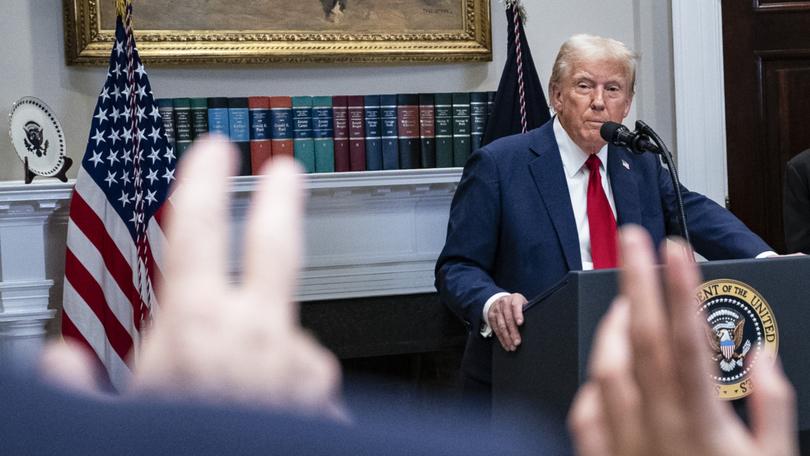THE NEW YORK TIMES: Donald Trump bars transgender women from US prisons for female inmates

President Donald Trump has ordered federal prisons to house inmates who are transgender women in men’s facilities and halt medical treatments related to gender transition.
The move was part of a wide-ranging executive order issued by Trump on his first day in office meant to limit government recognition of an individual’s gender to their sex at birth.
The directive on prisoners also applies to immigration detainees and is among the more concrete parts of the order. Trump set some restrictions on housing and health care for transgender prisoners in his previous term, but the new order was more far-reaching.
Sign up to The Nightly's newsletters.
Get the first look at the digital newspaper, curated daily stories and breaking headlines delivered to your inbox.
By continuing you agree to our Terms and Privacy Policy.The Women’s Liberation Front, which defines women based on sex at birth and advocates single-sex prisons, called the directive “a major victory.” The group is challenging a California law that allows prisoners to request housing that aligns with their gender identity. It argues that the law violates the constitutional rights of female inmates who are not transgender, including the Eighth Amendment right to protection from cruel and unusual punishment.
Trump’s order echoed those arguments, saying that “efforts to eradicate the biological reality of sex fundamentally attack women by depriving them of their dignity, safety and well-being”.
Advocates on behalf of transgender people and inmates criticised the order, saying it would put them in danger.
“There will be rapes and physical assaults because of this policy,” said Shannon Minter, legal director of the National Center for Lesbian Rights, which has represented transgender prisoners. “It’s also terrible for prison officials, who right now have the authority to use discretion about what makes the most sense for the safety and security of the facility.”
Legal experts said it would also be vulnerable to challenges in the courts. Federal courts have said that prison systems are required to protect vulnerable prisoners. Some have also held that they are required to offer medical care such as hormone therapies to prisoners diagnosed with gender dysphoria, the distress associated with a mismatch between one’s body and gender identity.
In 2022, a Federal district judge in Illinois ordered the bureau to provide gender-transition surgery for a transgender inmate after finding that denying the procedure was most likely a violation of the Eighth Amendment, which also guarantees the right to necessary medical care.
“Constitutional protections do not stop if a person is in prison or in jail, or in immigration detention facilities,” said Richard Saenz, a lawyer at Lambda Legal, an LGBTQ+ legal advocacy organisation.
Trump’s executive order, titled “Defending Women From Gender Ideology Extremism and Restoring Biological Truth to the Federal Government,” appears to require the rehousing only of transgender women, not transgender men.
The number of people affected is relatively small. There are about 1500 federal prisoners who are transgender women, according to the Bureau of Prisons. But they represent an outsize portion of federal inmates, especially among female prisoners: 15 per cent of women in prison are transgender. There are 750 transgender men out of about 144,000 male prisoners.
Transgender people make up less than 1 per cent of adults in the United States, according to the Williams Institute, a research centre at UCLA’s law school that studies the LGBTQ+ population. It is unclear why the number is higher in federal prisons, but experts point to studies that show transgender people are more likely to attract attention from law enforcement. They are also more likely to face family rejection and economic hardship.
Federal data shows that transgender prisoners are 10 times as likely to report being sexually victimised than other prisoners.
The Supreme Court acknowledged the vulnerability of transgender inmates decades ago in the 1994 decision Farmer v. Brennan. The plaintiff in the case was a transgender woman, Dee Farmer, who said she had been raped while housed with men. The court held that the government has a duty to protect prisoners from violence.
Farmer now heads Fight4Justice, a nonprofit advocacy group for LGBTQ+ prisoners, including one transgender woman who is currently on suicide watch after being targeted for abuse in the Washington, D.C., jail, she said. The jail is not a Bureau of Prisons facility.
The Bureau of Prisons has notified transgender prisoners of impending changes, she said, adding, “Yesterday I got three calls from inmates who were in a panic about what was about to happen to them.”
Under the Prison Rape Elimination Act, transgender status is one of several risk factors considered when housing assignments are determined. The new executive order calls for those regulations to be amended “as necessary.”
At the end of the Obama administration, the Bureau of Prisons released new guidance that transgender prisoners be housed according to their gender identity in most cases. In Trump’s first term, it was revised to require housing according to “biological sex,” except in rare cases. But the first Trump administration did not consider the issue a central policy priority.
President Joe Biden’s administration restored the Obama guidelines. During the 2024 presidential race, a key part of Republicans’ strategy was portraying Democrats as out of step with the mainstream on transgender issues. One widely aired ad attacked Vice President Kamala Harris for supporting “taxpayer-funded sex changes for prisoners” as a candidate in the 2020 Democratic primaries.
Some supporters of Trump had hoped that he would issue an executive order on his first day in office addressing transgender athletes in sports, which would affect many more people. But they welcomed the prison directive as a sign that he would take action on transgender issues.
“We’re encouraged to see these protections for privacy in women’s prisons and in rape shelters, ensuring that no woman ever has to face abuse, harassment or the loss of privacy and dignity from a man sharing these intimate spaces,” said Matt Sharp, senior counsel and director for public policy at Alliance Defending Freedom, a conservative legal advocacy group.
The order requires all gender transition medical care to cease, saying that no Federal funds should be spent “for any medical procedure, treatment, or drug for the purpose of conforming an inmate’s appearance to that of the opposite sex.”
The American Medical Association says treatments that “affirm gender or treat gender dysphoria” can be medically necessary. Such treatments may include psychological counselling, surgical procedures and hormone therapy.
Oestrogen in particular has several effects that are sought after by many trans women taking the hormone, including breast growth, thinner body hair and redistribution of body fat.
Halting treatment can reverse those effects. Jasmine Tasaki, a transgender woman who has been in prison and is now executive director of Black and Pink, a national organisation that advocates on behalf of incarcerated LGBTQ+ people, said taking it away from inmates would cause depression.
“If someone is taking hormones and they have breasts, their breasts would leave. Can you imagine as a woman watching your breasts leave?” she said.
Surveys and other studies show that transgender people across the country face particularly harsh treatment in the criminal justice system. When incarcerated, they are often housed according to the sex they were assigned at birth and report being provided with substandard medical care. They are also far more likely than other prisoners to be held in solitary confinement, which prisons often say is for their protection.
Tasaki said at times she had been held in isolation and was not permitted to bathe.
Under a new policy enacted in Florida last fall, prison officials forced transgender women to cut their hair, surrender their bras and overcome much tougher requirements to obtain gender transition-related treatment, according to a lawsuit filed by the American Civil Liberties Union.
This article originally appeared in The New York Times.
© 2025 The New York Times Company
Originally published on The New York Times
